How to clean silver at home?
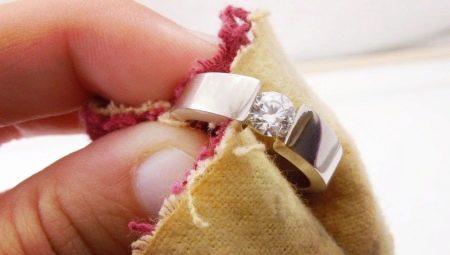
Silver has a seductive and refreshing sheen that lends elegance to cutlery and jewelry. It is surrounded by an aura of mystery, attributing mystical properties to this metal. Very often silverware is passed down by inheritance, thus emphasizing the special status of the family. However, with prolonged use, this metal begins to blacken, and products made from it need to be cleaned. Most owners prefer to do this at home, without going to specialized workshops.
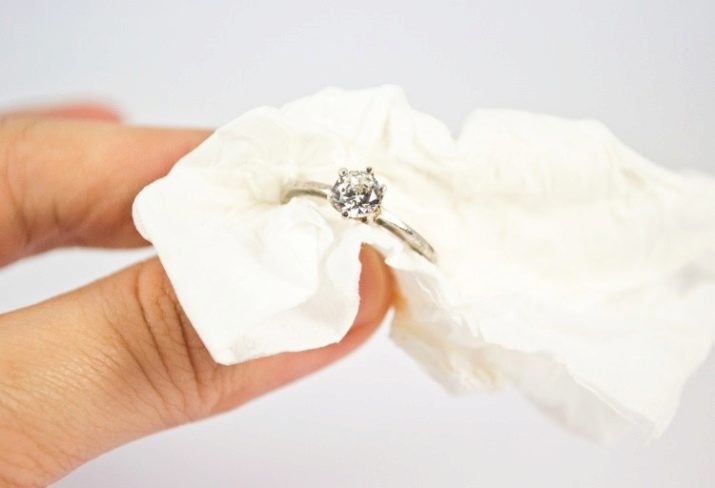
Darkening reasons
Silver items look very impressive and stylish, but this beautiful metal has such a drawback as a tendency to the appearance of a dark coating. This plaque is a gray or black film that forms on the surface of the metal due to its oxidation.
This process is completely natural and cannot testify to the influence of any dark forces on the bearer of the jewelry, as was commonly believed in the old days. Oxidation occurs as a result of active exposure to factors such as:
- ultra-violet rays;
- moisture and air with a high content of hydrogen sulfide;
- sulfur, which is one of the components of human sweat.
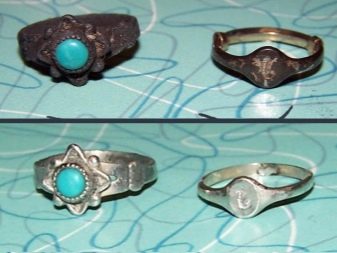

Accordingly, silver jewelry begins to darken in the following situations:
- With a long stay of their owner in the sun, especially at sea, since in this case all negative factors of influence merge together.
- When a person is engaged in such activities that are accompanied by significant sweating; it can be hard physical work or regular sports.
- With regular medication, and therefore the percentage of increased sulfur in the sweat increases.
- When interacting with certain types of cosmetics containing sulfur or hydrogen sulfide.
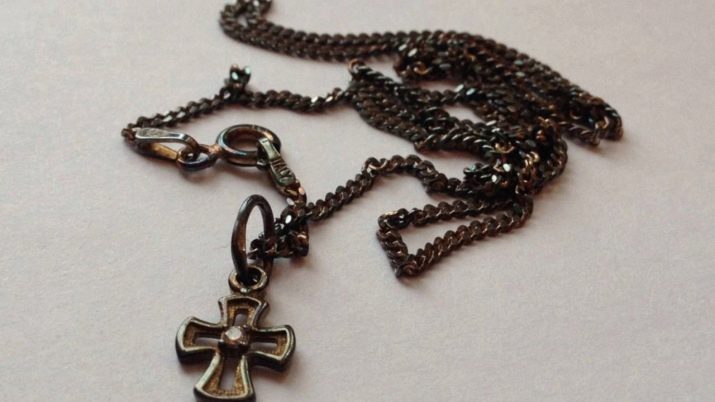
How to clean to make it shine?
The plaque that forms on the surface of silver is a chemical element called sulfur sulfide, which is not very durable and can be removed even at home. That's why you can independently clean almost any silver to a shineranging from jewelry to cutlery.
But the approach to cleaning may differ due to the quality of the metal and the presence of coating or inserts, which must be properly cleaned without violating the integrity and individuality of the jewelry.
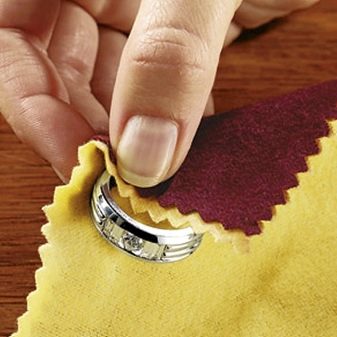

Among the silver items there are the following varieties:
- Items made of sterling silver. This metal has the highest standard of 925; the jewelry made from it delights with a dazzling shining white color and has remarkable durability.
- Blackened silver jewelry. These products can be of any sample, while they are united by the presence of exquisite niello, which can be especially saturated in the places of engraving.
- Jewelry with oxidation, having a brownish tint and reminiscent of antiques, darkened with age and therefore especially attractive.
- Colored silver jewelry, also called matte. They are coated with a special coloring compound called enamel, which makes them look very impressive and very popular.
- Gilded silver items covered with the thinnest natural gold film.


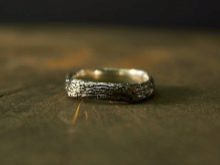

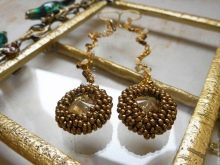
In addition, there are some varieties of white metal that are mistakenly referred to as silver:
- Droplet "silver", which is a chemical element of iron sulfide, or pyrite. Outwardly, this metal is very similar to sterling silver.
- Marcasite or radiant pyrite.
- Cupronickel.
For cleaning products made of substitute metals, which are jewelry, not all products recommended for silver may be suitable, therefore, before carrying out this procedure, you need to make sure which metal is used in the jewelry.
Focusing on the composition of the metal, do not forget about the presence of stones that are inlaid with jewelry, and use only gentle methods to clean them.
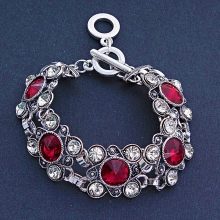
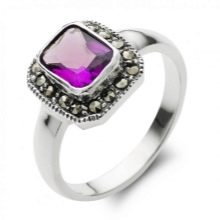

Ammonia
One of the most common methods is to clean silver items with an ammonia solution. A similar solution is also called ammonia or ammonia. It can be bought at any pharmacy and used at home according to one of the following recipes:
Recipe # 1 that has the greatest impact on pollution:
- 1 teaspoon of ammonia is mixed with 100 ml of water and a small amount of any liquid soap or dishwashing detergent;
- the decoration is placed in the prepared solution and is in it until the desired lightening effect is obtained;
- then the decoration is washed under running cold water and dried.
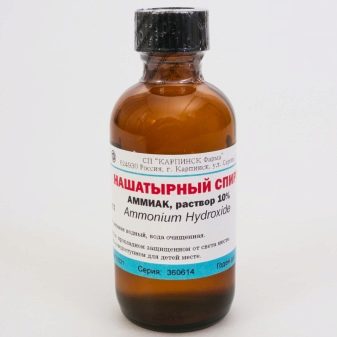
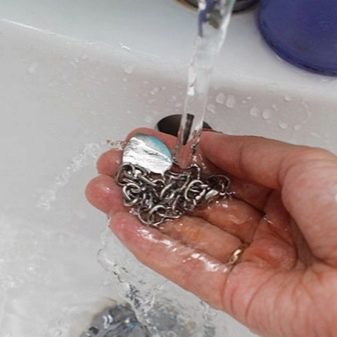
Recipe number 2, requiring the use of physical effort:
- ammonia, water and white toothpaste (without inclusions) are mixed in equal volumes;
- the product requiring cleaning is placed in this solution for 30 minutes;
- the wet product is processed with a toothbrush (with soft bristles) and wiped with a flannel cloth.
Since the ammonia mixture has a very pungent and unpleasant odor, such cleaning methods should not be used by people prone to allergies.But even a perfectly healthy person needs to carry out this procedure in a well-ventilated area. To reduce the smell, you can put the container with the composition on the balcony or loggia for the duration of the exposure to the product, by opening the windows there.
Using such methods, you can wash cutlery, wine glasses and silver jewelry of any sample that do not have stones from plaque.
But it is not worth using such means in order to clean blackened or oxidized silver, as well as enamelled metal, since in this case there is a great chance of spoiling the appearance of the jewelry.
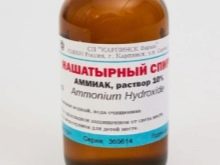
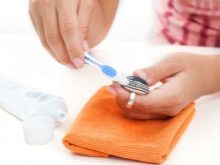

Vinegar
Black deposits on silver jewelry can be removed by applying a 9% food grade vinegar solution available in grocery stores. It perfectly copes with its task due to the acid content, which has a concentration sufficient to affect the sulfur sulfide film, but not capable of wreaking havoc on a metal as soft as silver.
If there are slight dirt on silver items, the easiest way is to wipe them off with a soft cloth dipped in a vinegar solution. In this way, without much difficulty, you can literally wipe silver tablespoons that have lost their shine in just five minutes. Also, in a similar way, you can clean products with precious stones without endangering them.
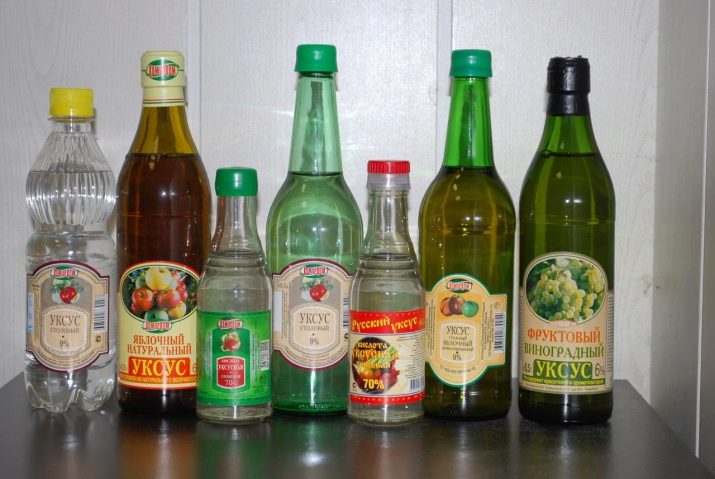
To cleanse more serious stains, the following options are suitable:
Method No. 1, designed to remove moderate contamination:
- products to be cleaned are placed in plastic dishes;
- then a 9% solution of food vinegar is poured in an amount sufficient to completely cover the items to be cleaned;
- for medium darkening, the exposure time is 20-30 minutes;
- more serious pollution requires exposure for one to two hours.
- then the product is washed under running water and polished with a soft cloth.

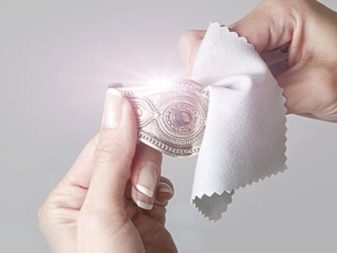
Method number 2 to help cope with chronic blackness on silver jewelry:
- pour 200 ml of table vinegar into an enamel pan and heat until the first bubbles appear;
- dip jewelry or objects to be cleaned into the solution;
- then remove the pan from heat and leave to act for 5-10 minutes;
- Carefully so as not to burn yourself, remove the cleaned items with tweezers, rinse them under running water and leave to dry on a soft cloth.
In relation to blackened or oxidized silver, these methods should not be used, since vinegar will remove the decorative coating in the same way as dirt.
It is also not recommended to use this cleaning method for people who are sensitive to strong odors.
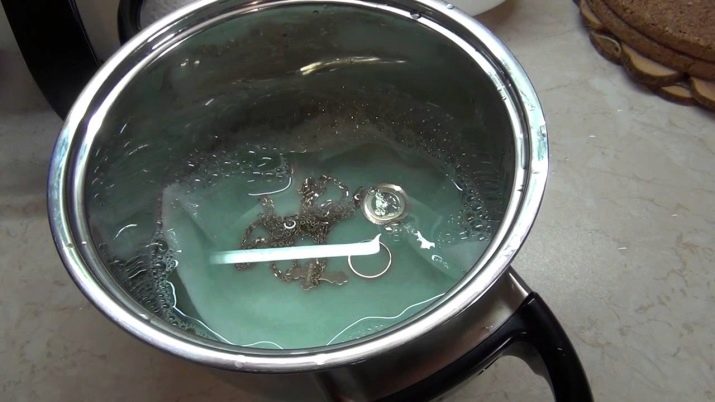
Hydrogen peroxide
The use of such a means as hydrogen peroxide for cleaning silver, it would seem, should not cause any special doubts, because everyone knows how effectively this substance is able to dissolve any dirt. However, in the case when we are talking about silver, it is necessary to take into account its composition in order to assess what kind of chemical reaction will occur when exposed to a given aggressive liquid and metal.
The use of hydrogen peroxide for the purification of silver will be successful only if the alloy contains no such constituent components, which can cause additional enhanced oxidation under the influence of peroxide.
Otherwise, an irreparable thing can happen to the decoration: it will blacken even more, and such an effect can be either fragmentary or complete.
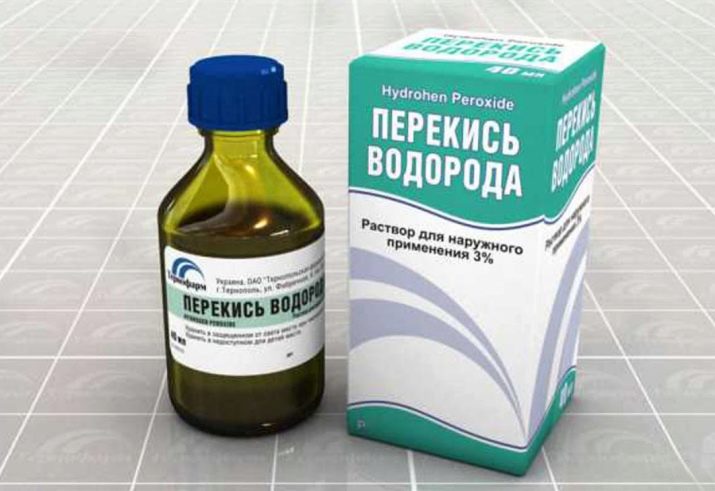
There are many complaints on the Internet that report similar effects of peroxide on silver jewelry. At the same time, it is mentioned that in order to “save” the damaged product, the owner had to go to a jewelry workshop, since they could not cope with such a reaction at home.
Since it is impossible to say absolutely exactly what kind of impurities are included in the composition of a particular silver alloy, then, at least, you should not risk using a substance such as hydrogen peroxide to purify it.
Toothpaste
Tooth powder is a very good means of cleaning soft surfaces, which include the surface of silver. Our grandmothers were well aware of this, successfully cleaning silver tea sets and vases with its help. The gentle action of the smallest particles of tooth powder not only successfully cleans the plaque that forms on the surface of the metal, but also produces a polishing effect, giving it a radiant shine.
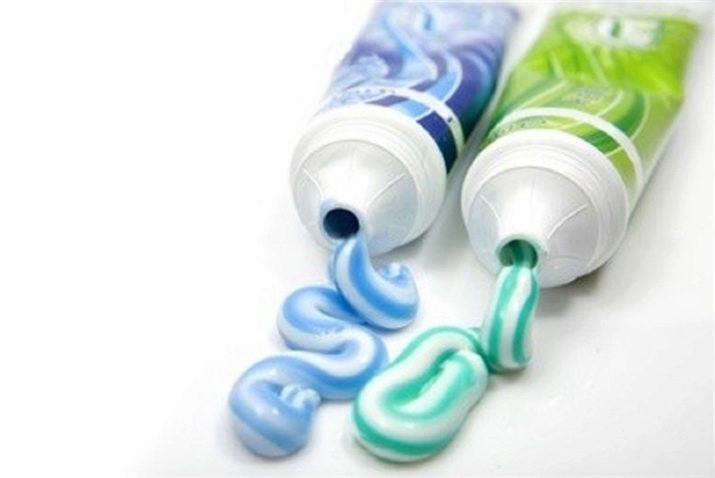
Tooth powder is quite difficult to find on the market these days, but it can be replaced with toothpaste. For the purpose of cleaning darkened silver, you need to purchase a white paste that does not have any additional inclusions or pigmented additives.
Gel-like toothpaste is also not suitable for cleaning, since it does not contain chalk, which is the main cleaning component.
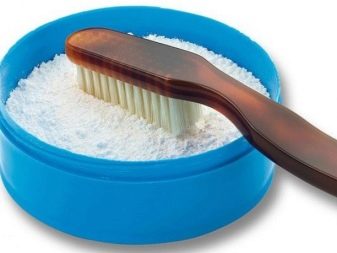
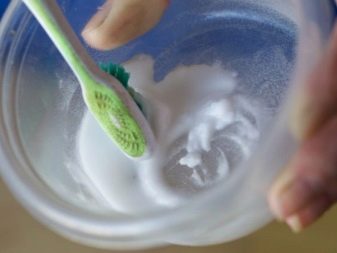
Cleaning options with toothpaste are as follows.
Method # 1, which works well for cleaning kitchen utensils, watches or silver figurines, however, will require the use of physical effort:
- toothpaste is applied to the surface of a toothbrush with soft bristles, a cotton swab or microfiber napkin;
- with careful circular movements, polish the product, starting from the most contaminated places;
- add paste if necessary, achieving complete removal of plaque;
- the cleaned product is washed under running water, after which it is wiped dry.
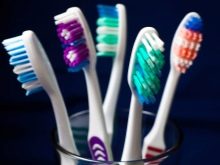
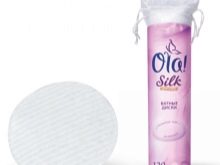
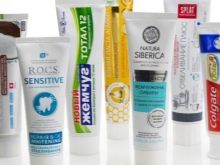
Method number 2. This method is suitable only for products with slight contamination:
- dilute a tube of toothpaste with water to the state of a liquid gruel;
- jewelry is soaked in this composition and left for an hour and a half for maximum impact;
- remove the products and rub them with a soft cloth, carrying out additional cleaning;
- wash off the remnants of the paste with running water, after which the jewelry is dried, wiping it from time to time.
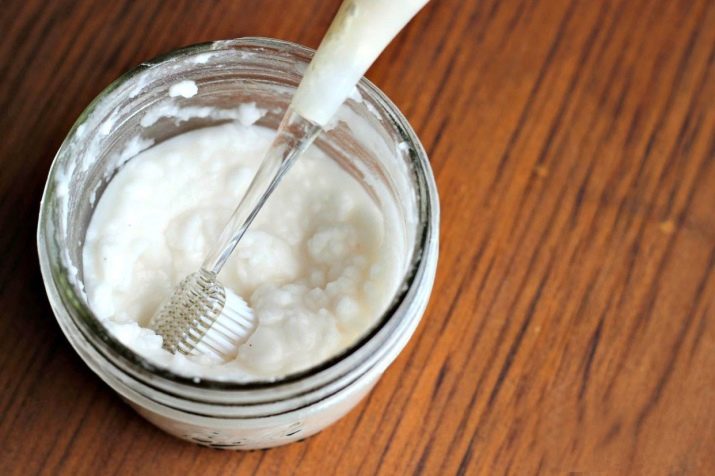
Method number 3, thanks to which, with the help of the simultaneous action of ammonia and toothpaste it is possible to clean the rather heavily darkened silver:
- toothpaste, water and ammonia are mixed in equal proportions;
- in the resulting composition, silver items are soaked for half an hour;
- remove products and polish them with a soft cloth;
- rinse the products in a large amount of water, dry them by wiping them and turning them over.
Some people consider using toothpaste to be the best way to remove blackness from silver, although this can be disagreed with. In any case, it is quite obvious that such a method cannot lead to damage to the product, since it is soft and gentle.
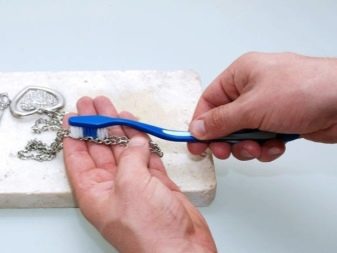
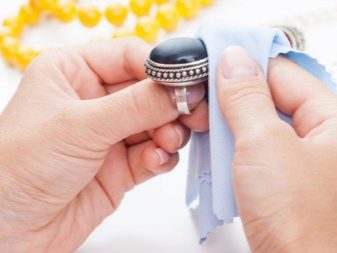
Citric acid
Citric acid is also called the E330 food supplement, and it is easy to get it at any grocery store. This product can also be used to clean silver items. Citric acid has good cleaning properties and is commonly used for descaling. It is equally successful in treating the black plaque that appears on silver and is a sulfur sulfide.
The process of its removal is a sample of a mild chemical reaction, for the full course of which it is required carefully observe all the prerequisites.
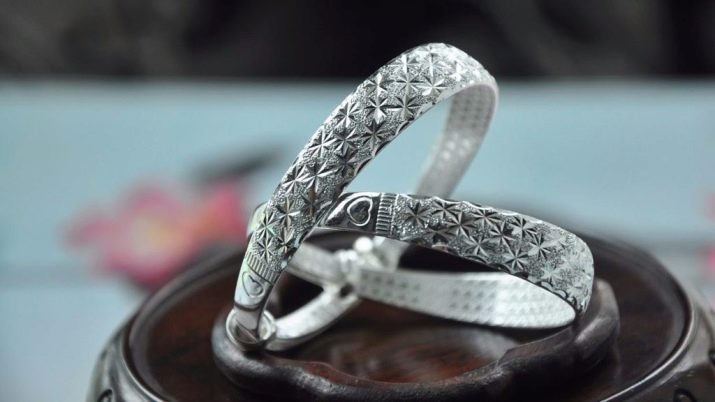
There are several ways to clean silver items with citric acid.
Method number 1, which will help to successfully cope with the most serious pollution:
- we dilute 50 g of citric acid in 250 ml of water, pour the resulting composition into a container for a water bath;
- the products to be cleaned are placed in the prepared solution;
- then put a small piece of copper wire in the same solution;
- heat the composition in a water bath to a boil, after which we boil for 30 minutes;
- carefully remove the silver items from the hot solution;
- We wash the silver under running water and let it dry, wiping it with a soft cloth from time to time (best of all, if it is microfiber).
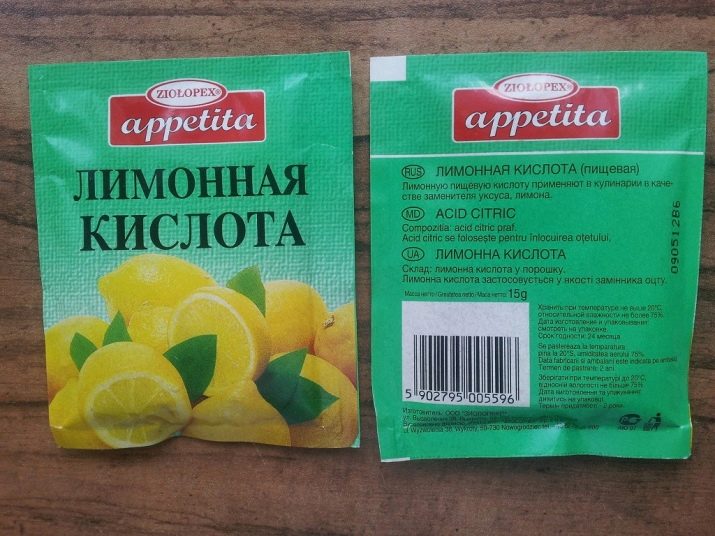
Method number 2, which is used for heavily darkened silver:
- we dilute citric acid in water in a ratio of 100 g to 500 ml of water;
- put food foil on the bottom of the enamel pan;
- place silver objects on the laid foil and slightly cover them on top with the edges of a sheet of foil;
- bring the composition to a boil over low heat, reduce the heat, continuing to boil until the silver is completely purified;
- while boiling in water, either small yellow or black flakes will appear, or the foil with which the silver comes in contact will turn black. This means that the cleaning proceeds normally and the sulfur sulfide is transferred from the silver to the liquid or to the aluminum surface;
- it is better to use tongs to remove items from a hot solution. You need to get it out very carefully, not allowing the flakes floating in the solution to settle on the silver.


Method number 3, which is the simplest and is suitable only for cleaning lightly soiled silver items:
- pour 1.5 liters of water into a saucepan;
- add 100 g of citric acid powder;
- bring the resulting solution to a boil, then turn it off;
- immerse silver objects in a hot solution and leave for half an hour;
- remove, rinse with water and wipe dry.

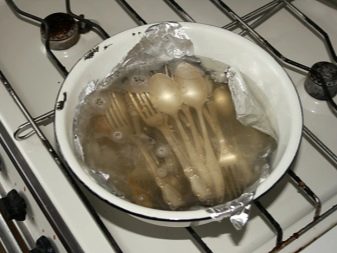
Salt
Very quickly, effectively and without any special tweaks, you can clean darkened silver items using such a simple tool as table salt. The advantage of using this substance is the fact that salt can be found in the kitchen of every housewife. Among the cleaning methods, there are both very simple ones, which are suitable in order to remove a small plaque from jewelry, and more complex ones, with which you can "bring back to life" even fossil spoons and forks. When using salt you should definitely inquire about the quality of the product.
Do not use iodized salt or "extra" salt for cleaning silver.

Method number 1, which can be recommended for cleaning not too darkened jewelry:
- we spread a soft fabric, it is better if it is flannel or microfiber;
- we lay out products that require cleaning on the surface of the fabric, and abundantly fill them with table salt;
- then we wrap the edges of the fabric and put the resulting package on the bottom of the plastic container;
- pour water into a container, completely covering the package;
- the exposure time of the agent is from 1 to 2 hours;
- we remove the products, rinse in running water and wipe.
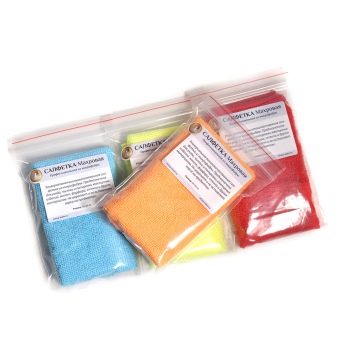
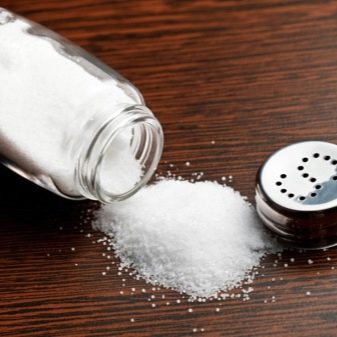
Method number 2 is suitable for moderate contamination:
- put food foil into a plastic container, on which we spread silver jewelry;
- abundantly fill the decorations with salt mixed in equal proportions with soda;
- then close the top with the edges of the foil;
- fill with hot water;
- leave for 1 hour for the composition to work;
- We take out the silver jewelry, rinse it under running water and polish it with a soft cloth until it shines.


Method number 3 is associated with the use of heat treatment, This is one of the most effective ways to "reanimate" blackened silver:
- lay out a piece of foil on the table, on which we lay out the decorations to be cleaned;
- fill the products with salt on top, trying to cover them "with a slide", then close the foil;
- pour a soap solution prepared from 1 teaspoon of any soap, grated on a fine grater (it is best to take laundry soap) and 200 ml of water into a saucepan;
- carefully place the foil in a saucepan with a solution;
- bring the contents of the pan to a boil, reduce the heat and leave to simmer for 15 minutes;
- carefully remove the products, put them on a saucer and leave them to cool completely;
- We wash the cooled jewelry under running water, then wipe it with a soft cloth, drying it and polishing it at the same time.
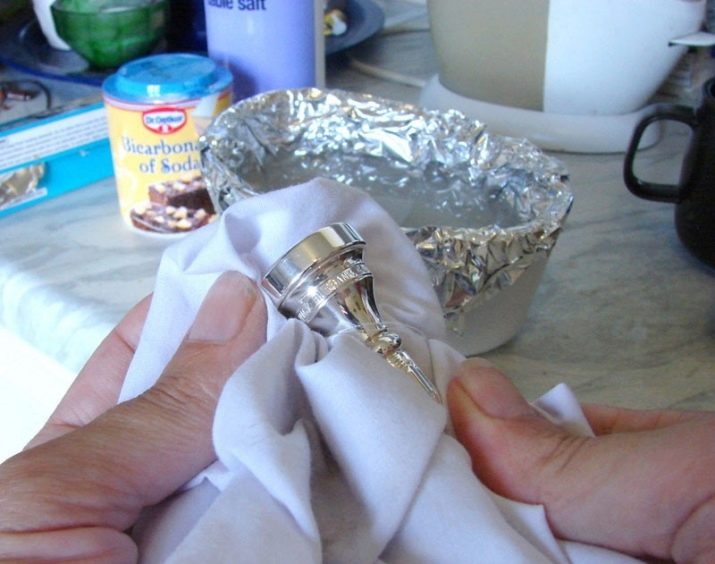
With Coca-Cola
There is a widespread belief that silver jewelry can be cleaned quickly and easily with a drink such as Coca-Cola. It really is the products placed in the Coca-Cola solution really brighten.
The disadvantage of this cleaning method is the fact that it is fragmented; after exposure to a carbonated solution, dark stripes and spots may remain on the product.

Accordingly, miracles cannot be expected from such a cleaning method, but it can be suitable for removing minor gray deposits from the surface of silver. This can be done in the following way:
- put the decoration in a plastic or metal container, which is poured with a Coca-Cola solution;
- leave for 1 hour;
- if during this time the Coca-Cola solution begins to change color and becomes lighter, this means that the cleaning process is successful;
- in the event that the color of the solution does not change, it is worth replacing it and pouring the product from another jar;
- after an hour, we remove the product from the solution, rinse it under running water and wipe it.
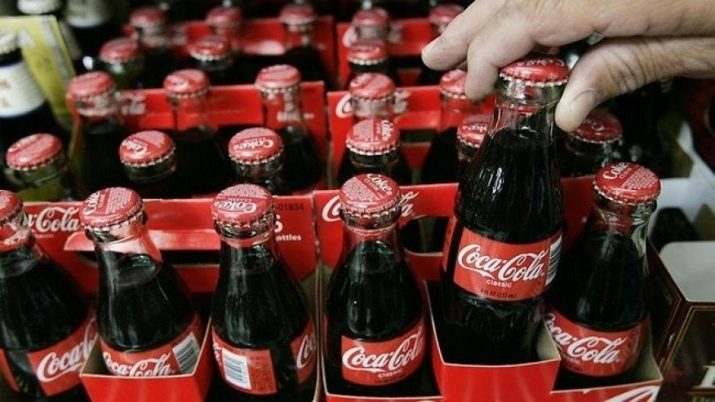
Cleaning green silver
In some cases, silver not only darkens, but also acquires a greenish coating. This usually happens with products made of alloy 875, which have a high content of copper in their composition, which gives exactly a green tint when oxidized. Such plaque can also be cleaned at home, but for this you have to use a special chemical - Trilon B.
Usually this substance is well known to plumbers and numismatists, as it is used to flush heating systems and ancient coins.
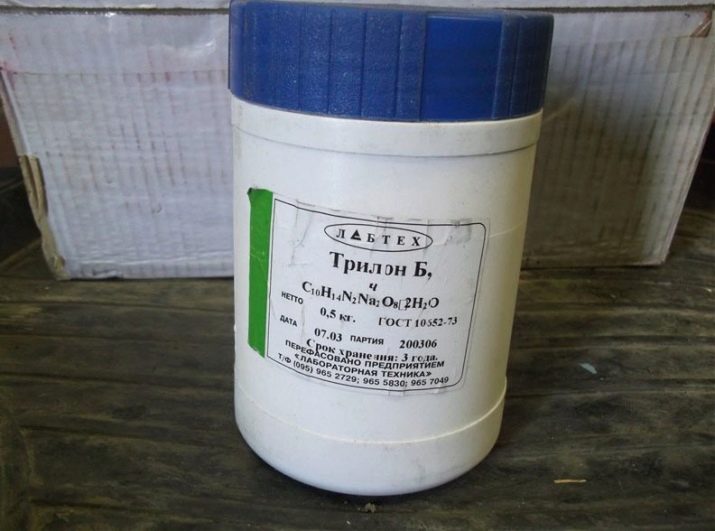
You can buy it either in the numismatic department, or in the stores of companies specializing in servicing heating systems. It costs 100 g of Trilon B from 200 to 400 rubles. It is imperative to work with this substance with gloves. You can not use iron dishes, as Trilon B enters into a chemical reaction with iron. To clear silver from green plaque, you need:
- prepare a 10% solution of Trilon B. To obtain a similar concentration, you need to take 10 g of the substance per 100 ml of warm water;
- soak the product for 15 minutes, it is advisable to clean each item separately in a fresh solution;
- to remove the product, you need to use a non-metallic object, for example, plastic tongs;
- then we wipe the product with a soft toothbrush, removing the greens from it, then rinse it in running water and dry it;
- to give silver brightness and shine, it is advisable to wipe it with a napkin moistened with ammonia.
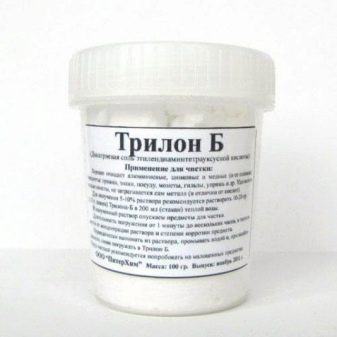

Other means
In addition to the above methods of removing plaque from silver, which can be called classic and time-tested, you can find quite a lot of very non-standard methods of cleaning this metal.
For example:
- using raw potatoes, for which you need to grate 1 potato on a fine grater and soak the product in the resulting gruel for 5 minutes;
- using the potato broth, left over after cooking, into which the decoration is dipped and "boiled" for 15-20 minutes;
- using the foil in which the decoration is placed, spread it on the bottom of a ceramic container and pour it with hot potato broth, leaving it for 20 minutes;
- using milk, in which the jewelry is "boiled" for 5-7 minutes, then removed, washed and wiped dry;
- with the help of egg yolk, to which add 1 tablespoon of "Whiteness" (a product containing chlorine). This composition is applied to the decoration with a toothbrush and rubbed, removing plaque.
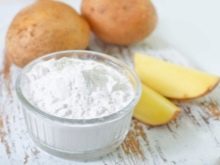

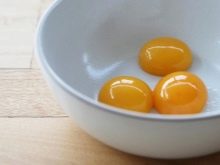
Professional remedies
Silverware can be cleaned using professional products that can be purchased at every jewelry store or in the hardware department of supermarkets. They are available in the form of pastes, aerosols and liquids.
These are drugs such as:
- Solution for the care of silver jewelry "Aladdin", which successfully helps to clean the jewelry within a minute (it is not recommended to keep the product in this product for more than two minutes due to its very concentrated composition). The cost of 50 ml is 63 rubles.
- Silver cleaner "Font" also copes well with dark bloom, costs 57 rubles for a 50 ml jar.
- Sunlight Jewelry Cleaner, which the manufacturer calls safe and effective for all types of jewelry, buyers rate it as very average; the cost of a 100 ml bottle ranges from 250 rubles to 500 rubles.
- "Universal stone", which is positioned as a tool for cleaning the whole house, including silver jewelry, is well appreciated by users; the cost of 800 g is 1800 rubles.
- Leuchtturm, which, according to manufacturers, is designed to clean old dirt, including green plaque, costs 400 rubles for 250 ml. After removing the dirt, this preparation creates a protective film on the surface of the product.
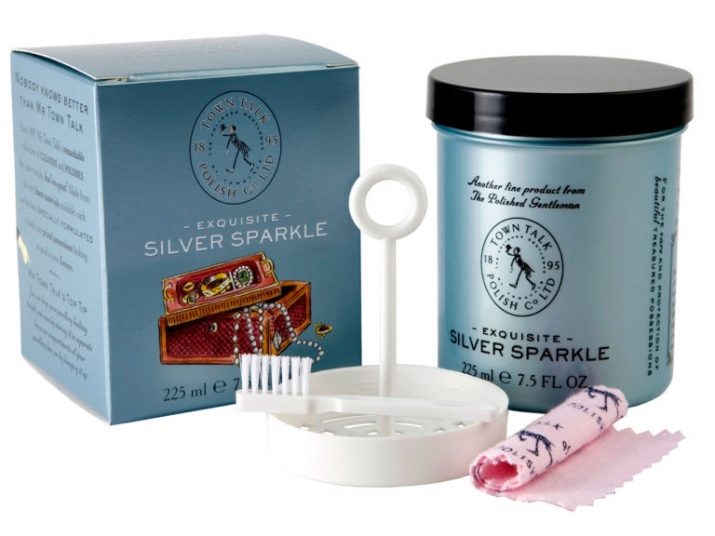
Jewelry care
Cleaning of jewelry is required when it comes to old silver. In the same situations, when the owner purchases a new product in the store, it is easier to prevent the growth of contamination and take preventive measures. This is especially true for items inlaid with precious stones or decorated with enamel or "niello".
Purification of blackened silver
For cleaning niello, enamel or oxidized silver jewelry that cannot be treated with any of the above methods, use olive oil:
- Apply 100% olive oil to a soft cloth, such as a microfiber cloth;
- we carefully wipe the decoration, trying not to press especially in places containing blackening;
- we wash the decoration with hot water without detergents and wipe it dry.
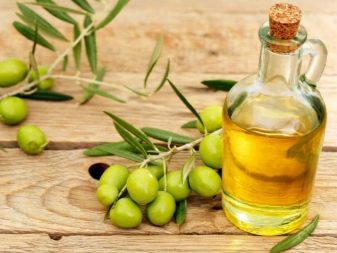
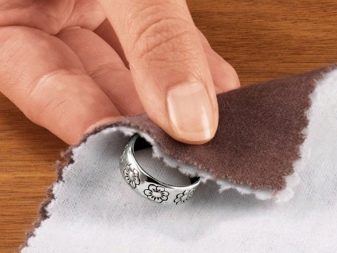
How to clean gold plated silver
Quite often, silver is covered with the thinnest layer of gilding, which gives the metal additional charm, but does not save it from darkening. Moreover, gilded silver requires special care when cleaning, since when processed with strong compounds, the gilding can peel off or scratches on it.
In order to prevent significant darkening of gilded silver, which will be very difficult to remove without problems, it is not worth starting this process. Care should be taken at the first "symptoms".
Soaking gilded jewelry in soapy water for half an hour is a good preventative measure. After the contamination is soaked, the products are washed in running water, then wiped until completely dry.
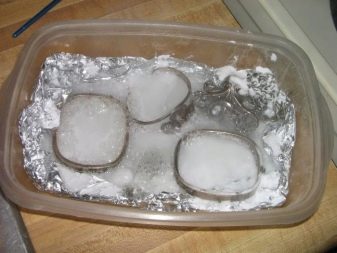
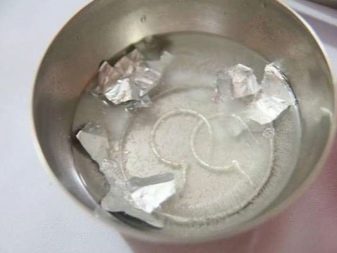
In the event that the soap solution does not cope, you can use ammonia or 9% table vinegar, but in very low concentration:
- we dilute 1 tablespoon of ammonia or food vinegar in 200 ml of water;
- we lower the gilded jewelry into the solution and leave it for 30 minutes;
- we remove the product and wipe it with a soft cloth, if necessary, treating it in darkened places with a cotton swab;
- then rinse in running water and wipe dry.
You can also clean gilded silver with alcohol-based liquids. It can be eau de toilette, vodka or brandy. The darkened jewelry should be wiped with a soft cloth dipped in an alcohol solution, then rinsed with clean water and wiped dry with a flannel napkin or chamois leather, which will give the gilding additional shine.
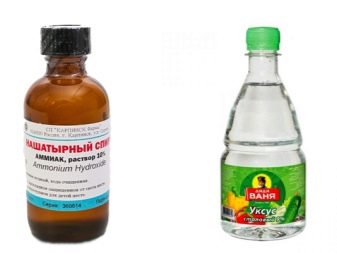
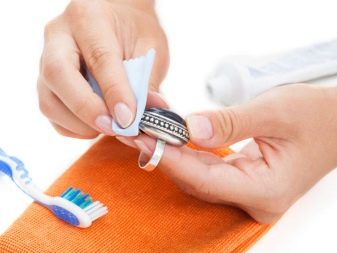
You can also clean the gilded silver in beer:
- to improve the effect, it is necessary to first degrease the surface with alcohol, removing excess contamination;
- fill the product with beer and leave for 1 hour;
- take out the jewelry, rinse it under running water and wipe it dry with suede.
Abrasive materials and various brushes for cleaning gilding should not be used, as they can leave scratches. Apart from home methods, there are chemical methods for cleaning gilded silver.

How to clean silver with stones
Precious stones give silver items a special charm, sophistication and nobility. In the event that a silver jewelry has inserts with precious stones, it requires particularly careful care. When cleaning such products, special gentle methods are required. Pearls, emeralds, rubies or corals should never be immersed in hot solutions or boiled over. Moreover, it is impossible to "cook" jewelry with stones, since when exposed to hot temperatures they lose their color.
When cleaning precious stones, it is important to understand that they have different densities and therefore require different methods of treatment.
Aquamarines, emeralds and sapphires embedded in silver can be cleaned using the following method:
- we make a soap solution from washing powder or shampoo, in which we place jewelry;
- leave for 2 hours to soften the plaque;
- wipe with a soft toothbrush;
- rinse and dry.
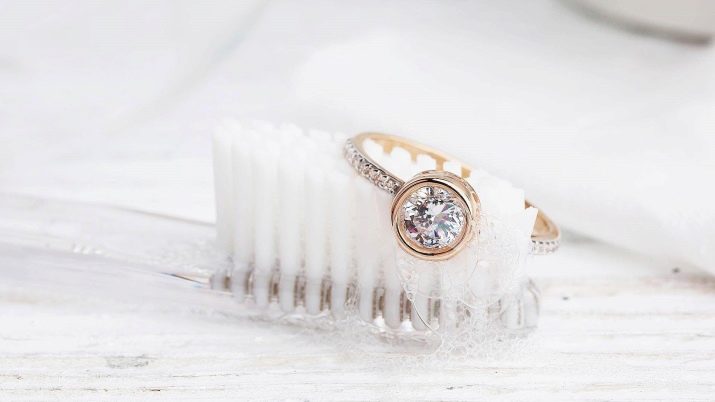
For malachite, turquoise, moonstone, opal and other stones that are considered gems, the use of brushing is contraindicated, washing powder should also be replaced with softer baby soap:
- we rub a bar of baby soap on a grater;
- Stir 1 tablespoon of soap shavings until completely dissolved with 400 ml of water;
- put silver jewelry with gems in a soapy solution and leave for 2 hours;
- take out, rinse and wipe with a microfiber cloth.

For those silver jewelry that has organic mineral inserts such as coral, pearls and amber, The best cleaning method is to proactively remove only visible plaque:
- for this product, you need to wash it with warm water with the addition of a small amount of laundry soap;
- rinsing is carried out under running water;
- it is strictly not allowed to wipe the stones and polish them;
- You can clean contaminated pearls by treating them with potato starch.
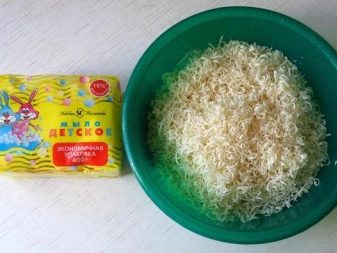
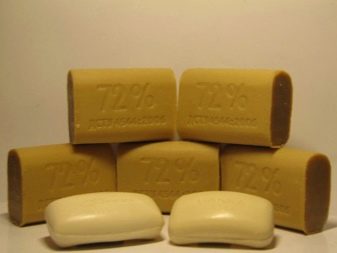
Tips for all occasions
As with gold, there are also rules for wearing and storing silver. They are very simple, but if you follow them, then products made of this magical metal will delight the owners for a long time with their radiance and purity.
These recommendations are simple:
- You should avoid wearing silver jewelry in places with high humidity: on the beach, in the pool, in the sauna.
- You should never sleep in silver jewelry.
- They should be worn already when makeup is applied and perfume is sprayed in order to avoid contact with the chemical components of cosmetics.
- After removing jewelry, wipe it with a soft microfiber cloth to get rid of sweat and sebum.
- Store them separately from medicines.

- Never throw away jewelry made of silver, as it is a very soft metal, on which scratches from impacts quickly appear, which can only be removed in a jewelry workshop.
- Don't put all your jewelry in one place. Store rings and earrings in separate jewelry boxes. It is better to hang the storage chains.
- In the event that any silver jewelry is rarely worn, it is better to wrap it in foil for storage, thereby excluding air access.
- After the procedure for cleaning silver jewelry, it is undesirable to immediately start using them. Over the course of several days, a protective layer will form on the surface of the metal that is not in contact with the skin, which will help maintain its appearance for a longer time.
- It is advisable to put a few pieces of chalk in a box for storing silver items, which will absorb excess moisture, preventing the metal from darkening.
For information on how to clean silver at home, see the next video.








